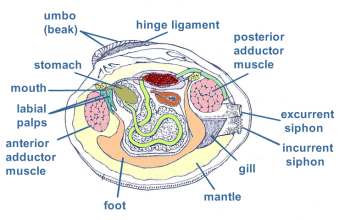|
Clams
are bivalves, meaning that they have shells
consisting of two halves, or valves.

The valves
are joined at the top, and the adductor muscles
on each side hold the shell closed. If the
adductor muscles are relaxed, the shell is
pulled open by ligaments located on each side of
the umbo.
The clam's foot is
used to dig down into the sand, and a pair of
long siphons that extrude from the clam's
mantle out the side of the shell reach up to the
water above (only the exit points for the
siphons are shown).
Note: this image is colored to
differentiate internal organs and are not the
actual colors of the clam.
Clams are filter
feeders. Water and food particles (and anything
else that may be floating by) are drawn in
through the incurrent siphon where tiny, hair-like
cilia move the
water to the gills. Food is caught in mucus
produced by the
gills. The gills also draw oxygen from the water
flow.
From there, the
cilia move the particles along food grooves
toward the labial palps,
where they are sorted. The labial palps secrete
a mucus that entangles suspended food and
nutrient particles within the water to produce a
ball of food and mucus called a
bolus. Afterwards,
cilia on the palps direct the bolus into the
mouth.
Other particles—such as silt
or excess phytoplankton—are dropped onto the
surface of the mantle, where the clam eventually
gets rid of them in mucous-coated balls.
Food is processed
by the digestive system which includes the
stomach, intestines, rectum and anus.
<click
here> or on the image for more details
The excurrent siphon carries away the
water, disregarded (non-food) particles and
waste.
|
